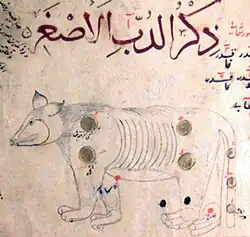Risālat al-Ṣūfī fī al-kawākib
%252C_double_frontispiece._Ibn_al-%E1%B9%A2%C5%ABf%C4%AB%252C_Ris%C4%81lat_al-%E1%B9%A2%C5%ABf%C4%AB_f%C4%AB_al-kaw%C4%81kib_Probably_Baghdad%252C_c._1225._Tehran%252C_Reza_Abbasi_Museum%252C_M._570.jpg) Old sage with a young prince (Ibn al-Ṣūfī and his patron-prince?), double frontispiece. Ibn al-Ṣūfī, Risālat al-Ṣūfī fī al-kawākib Probably Baghdad, c. 1225. Tehran, Reza Abbasi Museum (RAM), M. 570 | |
| Author | Ibn al-Ṣūfī (or one of his sons) |
|---|---|
| Original title | رسالة الصوفي في الكواكب |
| Language | Arabic |
| Subject | Astronomy |
| Genre | Poem |
| Published | 10th-11th century |
| Publication place | Rayy, Iran |
| Media type | Manuscript |
Risālat al-Ṣūfī fī al-kawākib (Arabic:رسالة الصوفي في الكواكب, "Epistle of al-Ṣūfī on the Stars"), is an 10-11th-century poem, probably composed in Rayy, Iran. It was authored by Ibn al-Ṣūfī, or most probably one of his sons.[1][2] It is a poetic supplement to Ibn al-Ṣūfī's astronomical opus The Book of Fixed Stars, in the urjūza genre.[3]
The text is known from a 13th century manuscript, possibly composed in Baghdad, now in Tehran, Reza Abbasi Museum (RAM M. 570), also called "RAM al'Sufi". It is stylistically dated to circa 1225.[1] An inscription in the manuscript gives a date of AH 554 (1159 CE), but this is probably a later interpolation.[4]
The manuscript has various depictions of the constellations, using various human and animal figures.[5] Several of the figures are wearing Turkic clothing, such as Centaurus, who has a Turkic sharbush headgear.[6]
Another Qajar copy exists, dated ̣to 1894 (Tehran, Majlis Library, no. 5099).[7]
-
.jpg) Title of Risālat al-Ṣūfī fī al-kawākib
Title of Risālat al-Ṣūfī fī al-kawākib -
 Cassiopeia. Ibn al-Ṣūfī, p. 24
Cassiopeia. Ibn al-Ṣūfī, p. 24 -
![Centaurus and Lupus. Ibn al-Ṣūfī, p. 72. Centaurus has a Turkic sharbush headgear.[6]](./_assets_/Centaurus_and_Lupus._RAM_Ibn_al-%E1%B9%A2%C5%ABf%C4%AB%252C_p._72.jpg)
-
 Aquila. Ibn al-Ṣūfī, p. 31
Aquila. Ibn al-Ṣūfī, p. 31 -
 Ursa Minor. Ibn al-Ṣūfī, p. 5
Ursa Minor. Ibn al-Ṣūfī, p. 5 -
![Centaurus (detail) with a Turkic sharbush headgear and clothing.[6]](./_assets_/Centaurus_and_Lupus._RAM_Ibn_al-%E1%B9%A2%C5%ABf%C4%AB%252C_p._72_(detail).jpg)
References
- ^ a b Contadini 2012, Plate 14.
- ^ Contadini 2006, pp. 50–51.
- ^ Contadini 2006.
- ^ Contadini 2006, p. 47: "Given the close relationship of the urjuza miniatures to those in other early-thirteenth-century manuscripts, we would expect the RAM Risalat al-Sufi fi al-kawakib to be datable to ca. 1220-25. It is therefore suprising [sic] that on page 4 we find an inscription giving a date of 554 (1159); were this the actual date of the manuscript, it would require a drastic reappraisal of currently accepted views on the chronology of stylistic evolution. There are, however, good reasons for thinking it a later interpolation."
- ^ Contadini 2012, p. 7.
- ^ a b c Contadini 2012, p. 81, "...Centaurus being represented with an elaborate sharbūsh".
- ^ Contadini 2012, p. 172.
Sources
- Contadini, Anna (1 January 2012). A World of Beasts: A Thirteenth-Century Illustrated Arabic Book on Animals (the Kitāb Na‘t al-Ḥayawān) in the Ibn Bakhtīshū‘ Tradition. Brill. doi:10.1163/9789004222656_005.
- Contadini, Anna (2006). "A Question in Arab Painting: The Ibn Al-Sufi Manuscript in Tehran and Its Art-Historical Connections". Muqarnas. 23: 47–84. ISSN 0732-2992.